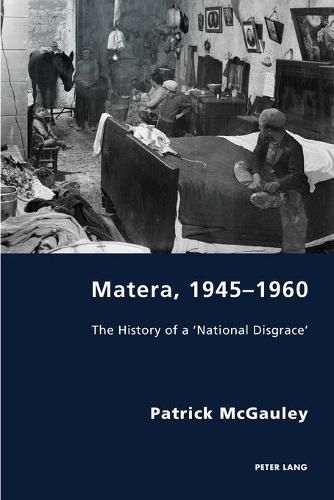Readings Newsletter
Become a Readings Member to make your shopping experience even easier.
Sign in or sign up for free!
You’re not far away from qualifying for FREE standard shipping within Australia
You’ve qualified for FREE standard shipping within Australia
The cart is loading…






This title is printed to order. This book may have been self-published. If so, we cannot guarantee the quality of the content. In the main most books will have gone through the editing process however some may not. We therefore suggest that you be aware of this before ordering this book. If in doubt check either the author or publisher’s details as we are unable to accept any returns unless they are faulty. Please contact us if you have any questions.
The southern Italian city of Matera was dubbed a national disgrace in the immediate post-war period due to media and political focus on its distinctive cave homes, the Sassi, which housed an estimated 15,000 people in the early 1950s. The Italian government implemented a rehousing programme for Matera’s cave dwellers in 1952. As a result, the Sassi were gradually emptied and the local population was rehoused in purpose-built rural villages and urban quarters. However, the rehousing programme was beset by numerous problems and was never fully completed.
This book explores how and why Matera came to be viewed in such negative terms and investigates the impact this had on the city’s social and urban development. Drawing on previously neglected primary sources, it charts the discursive construction of Matera as a national disgrace in the context of post-war Italy’s complex political landscape, renewed interest in the southern question, and narratives of the Italian nation. These themes are examined through the lens of recent scholarship in the history of emotions, the history of nationalism, urban history, and the new southern history.
$9.00 standard shipping within Australia
FREE standard shipping within Australia for orders over $100.00
Express & International shipping calculated at checkout
This title is printed to order. This book may have been self-published. If so, we cannot guarantee the quality of the content. In the main most books will have gone through the editing process however some may not. We therefore suggest that you be aware of this before ordering this book. If in doubt check either the author or publisher’s details as we are unable to accept any returns unless they are faulty. Please contact us if you have any questions.
The southern Italian city of Matera was dubbed a national disgrace in the immediate post-war period due to media and political focus on its distinctive cave homes, the Sassi, which housed an estimated 15,000 people in the early 1950s. The Italian government implemented a rehousing programme for Matera’s cave dwellers in 1952. As a result, the Sassi were gradually emptied and the local population was rehoused in purpose-built rural villages and urban quarters. However, the rehousing programme was beset by numerous problems and was never fully completed.
This book explores how and why Matera came to be viewed in such negative terms and investigates the impact this had on the city’s social and urban development. Drawing on previously neglected primary sources, it charts the discursive construction of Matera as a national disgrace in the context of post-war Italy’s complex political landscape, renewed interest in the southern question, and narratives of the Italian nation. These themes are examined through the lens of recent scholarship in the history of emotions, the history of nationalism, urban history, and the new southern history.